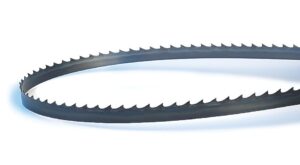Band Saw Blade
A band saw (also written band saw) is a power saw with a long, sharp blade consisting of a continuous band of toothed metal stretched between two or more wheels to cut material. They are used principally in woodworking, metalworking, and lumbering, but may cut a variety of materials. Advantages include uniform cutting action as a result of an evenly distributed tooth load, and the ability to cut irregular or curved shapes like a jigsaw. The minimum radius of a curve is determined by the width of the band and its kerf. Most band saws have two wheels rotating in the same plane, one of which is powered, although some may have three or four to distribute the load. The blade itself can come in a variety of sizes and tooth pitches (teeth per inch, or TPI), which enables the machine to be highly versatile and able to cut a wide variety of materials including wood, metal and plastic.
There are two types of band saws available in the market – one is the horizontal band saw and the other is vertical band saw. Band saws have become fairly common in any machine shop and require no special skills to use. However, considering the nature of work involved, it is important that you familiarize yourself with the equipment and follow a few simple steps when using a band saw.
The two most commonly used models of band saw machines are horizontal and vertical machines. We’ll give you a general description of each type followed by the key differences between the two.
While using a horizontal band saw, the work piece is held stationary by a vice and the blades move across in a horizontal direction and then downward in order to cut through the metal. These machines are commonly used in larger manufacturing companies and industrial workshops. The advantages of a horizontal band saw are typically higher cutting rate and superior squareness. Horizontal band saws also typically offer longer blade life.
While using a vertical band saw, the work piece is held on the table with a vise, and the blade column pushes towards the operator until the piece is cut through. The vertical band saw in many cases has the ability to miter cut angles in the work piece as well.
Size Range
All Band Saw Blades are available in multiple sizes as required by the customer. Please see below for more information
Grade
All Band Saw Blades are available in M42 Bimetallic, M51 Bimetallic or Carbon Steel Grades. Please see below for more information
Edge Configuration
All Band Saw Blades are available in multiple edge configurations depending on the TPI required by the customer. Please see below for more information



Don't know what kind of blade is suitable for your application. Contact us and we will figure it out for you.
Reach us at thirumala@timama.org or call 0091 44 28230444 / 0091 9962090100
